


| #5 has Christy art. |
 |
So do issues #s 2, 3 & 5 of |
 Born
in 1873, Howard Chandler Christy was just 22 when the first "Christy
Girl" (at right) was published in the November 1895 issue
of The Century magazine. Actually, he produced four images
for the story, The Tragedy of the Comedy, by Chester
Bailey Fernald (who?) and they depicted five women and little
else. Like his contemporaries, W.T. Benda, Franklin Booth, Frank Craig, Harrison Fisher, and J.C. Leyendecker, he was a young artist in
New York at a time when the magazines of the day were clamoring
for images.
Born
in 1873, Howard Chandler Christy was just 22 when the first "Christy
Girl" (at right) was published in the November 1895 issue
of The Century magazine. Actually, he produced four images
for the story, The Tragedy of the Comedy, by Chester
Bailey Fernald (who?) and they depicted five women and little
else. Like his contemporaries, W.T. Benda, Franklin Booth, Frank Craig, Harrison Fisher, and J.C. Leyendecker, he was a young artist in
New York at a time when the magazines of the day were clamoring
for images.
 He came to the city from Ohio in
1890 when he was 16 to attend the Art Students League where
he studied under William Merritt Chase. But his funds quickly
ran out and he was forced by economic circumstances to return
to Ohio. Two years later, he returned and studied with Chase who
was promoting "plein air" as the way to
paint. Chase didn't start his own school until 1896, so it's likely
that these were private lessons at a preliminary version of the
school. An example of his work with Chase from circa 1892-94 is
at left. This direct-from-nature method suited Christy perfectly
and his work was soon in demand. At some point, Christy attended
the National Academy of Design. It may have been while
he was still a student there that he received that first 1895
commission from The Century. The editors were always on
the lookout for upcoming young artists and Christy was a standout
student.
He came to the city from Ohio in
1890 when he was 16 to attend the Art Students League where
he studied under William Merritt Chase. But his funds quickly
ran out and he was forced by economic circumstances to return
to Ohio. Two years later, he returned and studied with Chase who
was promoting "plein air" as the way to
paint. Chase didn't start his own school until 1896, so it's likely
that these were private lessons at a preliminary version of the
school. An example of his work with Chase from circa 1892-94 is
at left. This direct-from-nature method suited Christy perfectly
and his work was soon in demand. At some point, Christy attended
the National Academy of Design. It may have been while
he was still a student there that he received that first 1895
commission from The Century. The editors were always on
the lookout for upcoming young artists and Christy was a standout
student.
Aside: While writing these biographies, I sometimes get sidetracked trying to confirm a bit of information. In this case, I came across the following in the Christy biography on the National Museum of American Illustration site:
"His fame and reputation were secured with his picture, 'The Soldier's Dream' published in Scribners. The girl he portrayed in that and subsequent paintings became known as 'The Christy Girl'."
The various references seem to place this image as after the Spanish-American War and, since the "Christy Girl" was established enough by 1906 to be used as the title of a book, it must have been somewhat before 1905. Well, I looked in every issue of Scribner's from 1895 to 1912 without finding a trace of such a picture. Does anybody have any further information about it? I'd like to reproduce it if it can be located. It depicts a soldier smoking a pipe and a woman appearing in the smoke. It sounds VERY similar to the image at right, "It is not only bullets that wound", but is supposed to be a different image. Help!
A little-known aspect of Christy's early career is the edition of Hamlet that he did for Dodd-Mead in 1897. It is profusely illustrated in b&w and in it he continues to develop his interpretations of femininity. See below. The role this book played in establishing his reputation and in the defining of the "Christy Girl" has yet to be determined, but it demonstrates that at the age of 24, he was already a proficient and respected illustrator.
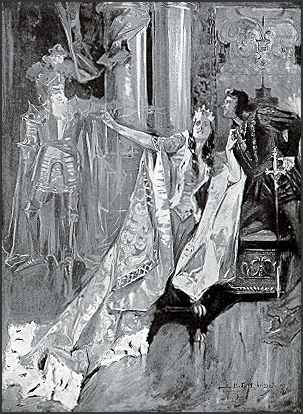
In 1898 he provided a few illustrations to a serialized article on the Revolutionary War for Scribner's Magazine. A few months later the magazine sent him and fellow artist, F.C. Yohn to Cuba to cover the Spanish American War. The young men were likely friends as Yohn was all of 23 at the time and a fellow Art Students League graduate. Christy met Teddy Roosevelt en-route and drew many illustrations of the soon-to-be-famous Rough Riders.
Another aside: In the recent Famous American Illustrators, author Ermoyan writes that Christy "did a portfolio of sketches of the Rough Riders which was published as a book." Anyone have any idea of which book this was? I'm still looking for a copy - or even a title.
 |
| Wounded Rough Riders Coming Over the Hill at Siboney |
His first war illustration, above, was for a report written by Richard Harding Davis for the September 1898 issue. He did another, larger painting (though reproduced smaller here) for a two-page article he himself wrote for the same issue. An Artist at El Poso reports the stirring events leading up to and culminating in The Fight at the San Juan Block-house, July 1st. That's the title of the painting below. In the magazine, it carries the additional notation "(The artist was an eye-witness.)" Other biographies all state that it was these war pictures that made his reputation. Perhaps, but there really weren't that many of them (perhaps only 15 or so in Scribner's and others in Leslie's Weekly - unless the Rough Rider portfolio book turns up). Nor, other than the one article he wrote, was there any special attention paid to him in print. Many of the images were actually drawings recreating other people's photographs - without even a bi-line for him as the artist. I'm sure that this work enhanced his reputation, but that this limited exposure might have skyrocketed him to fame is problematic.

 To
my mind, it was a growing body of work including his illustrations
for the 1897 Hamlet and (see left) for The Lion and
The Unicorn in the August 1899 issue of Scribner's
that launched both his career and the notion of the Christy Girl.
The Lion and The Unicorn was by the popular author,
and by then very famous war correspondent, Richard Harding Davis.
Reteaming with Davis, the one-time editor of Harper's Weekly,
must have been done with Davis' approval - no small recommendation
at the time - and Christy's languid female figures in lush drapery
were the perfect counterpoint to the pen & ink Gibson Girl
of the day. As Gibson was another favorite illustrator of Davis
stories, the comparison was begged to be made.
To
my mind, it was a growing body of work including his illustrations
for the 1897 Hamlet and (see left) for The Lion and
The Unicorn in the August 1899 issue of Scribner's
that launched both his career and the notion of the Christy Girl.
The Lion and The Unicorn was by the popular author,
and by then very famous war correspondent, Richard Harding Davis.
Reteaming with Davis, the one-time editor of Harper's Weekly,
must have been done with Davis' approval - no small recommendation
at the time - and Christy's languid female figures in lush drapery
were the perfect counterpoint to the pen & ink Gibson Girl
of the day. As Gibson was another favorite illustrator of Davis
stories, the comparison was begged to be made.
This was followed the same year by his book illustrations for Paul Leicester Ford's short story, Wanted ~ A Matchmaker, with more of the same. It was their sensuality tightly wrapped in their overdressed respectability that made his women stand out. And they seemed somehow more approachable than their Gibson counterparts - equally sure of themselves, but not quite so remotely idealized.

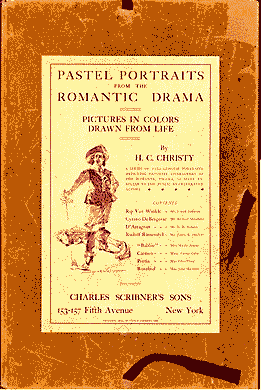 Whatever
the source of his fame, by 1899, Christy was a star. One of the
most ornate manifestations of this status was his magnificent
portfolio - Pastel Portraits from the Romantic Drama.
The 14"x21" portfolio of eight large (10¼"x17")
tipped-on color plates featured full-length portraits of famous
actors of the day. Each actor or actress (four each) is shown
in full costume and make-up for a major character role. Joseph
Jefferson (at right) is Rip Van Winkle, Richard Mansfield
is Cyrano, Ellen Terry is Portia and Maude Adams
is "Babbie".
Whatever
the source of his fame, by 1899, Christy was a star. One of the
most ornate manifestations of this status was his magnificent
portfolio - Pastel Portraits from the Romantic Drama.
The 14"x21" portfolio of eight large (10¼"x17")
tipped-on color plates featured full-length portraits of famous
actors of the day. Each actor or actress (four each) is shown
in full costume and make-up for a major character role. Joseph
Jefferson (at right) is Rip Van Winkle, Richard Mansfield
is Cyrano, Ellen Terry is Portia and Maude Adams
is "Babbie".
There are other large-format books of the era that feature
Christy images, but this portfolio is fairly unique in that the
plates were done especially for this presentation and appeared
here for the first time. Scribner's was selling these based
on the Christy name, and they must have been fairly confident
in his popularity to risk what must have been a considerable investment
in a unique presentation.
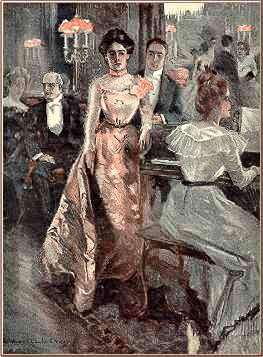 Christy
appeared regularly in magazines through 1905. At right is a rather
tentative two-color cover for the January 1900 issue of The
Ladies Home Journal. The early 1900's were a period of intense
effort. His work appeared in more and more books and in all the
major magazines of the day - Harpers, Scribner's,
Century, McClures, etc. The books were illustrated
primarily in b&w, but as color printing became more prevalent,
Christy's abilities with color were also very much in demand.
A partial list of these early books includes:
Christy
appeared regularly in magazines through 1905. At right is a rather
tentative two-color cover for the January 1900 issue of The
Ladies Home Journal. The early 1900's were a period of intense
effort. His work appeared in more and more books and in all the
major magazines of the day - Harpers, Scribner's,
Century, McClures, etc. The books were illustrated
primarily in b&w, but as color printing became more prevalent,
Christy's abilities with color were also very much in demand.
A partial list of these early books includes:
1899: The Lion & The Unicorn (R.H. Davis)
1900: Wanted ~ A Matchmaker (P.L. Ford),
1901: The Cavalier (George W. Cable), The Crisis (Winston Churchill), The Dolly Dialogues (Anthony Hope), Heroines of Fiction (W.D. Howells), The Old Gentleman of the Black Stock (Thomas Nelson Page), The Ways of the Service (Frederick Palmer)
1902: Dorothy Vernon of Haddon Hall (Charles Major), The Fifth String (John Philip Sousa), La Lettre D'Amour in Ranson's Folly (R.H. Davis), The Maid-At-Arms (Robt. W. Chambers), Wanted ~ A Chaperon (P.L. Ford)
1903: The Courtship of Miles Standish (Henry Wadsworth Longfellow), Lady Rose's Daughter (Mrs. Humphry Ward), An Old Sweetheart of Mine (James Whitcomb Riley), The Under Dog (F. Hopkinson Smith), Under the Rose (Frederic S. Isham)
1904: The Castaway (Hallie Erminie Rives), Her Infinite Variety (Brand Whitlock)
1905: Drawings (in the large oblong folio format of the Gibson books), Evangeline (H.W. Longfellow), House of a Thousand Candles (Meredith Nicholson)

See another plate from "The Lady of the Lake"
in ImageS #5.
In 1903, with Miles Standish (from whom the Christy family could trace descent) in color and An Old Sweetheart in photogravure, Christy helped inaugurate the gift book format. He would do several others over the years, including The American Girl and The Christy Girl, both in 1906. Two of my favorites are Sir Walter Scott's The Lady of the Lake in 1910 (above) and the companion Tennyson volume, The Princess in 1911. Both were large-format, color-plate books with additional two-color illustrations throughout on every page.
Yet another aside: there are people on the web and at swap meets selling individual plates from these books for $75 and more! Folks, these books are NOT rare. If they are getting even a little rare it is because these 'book breakers' are taking them apart to sell to unsuspecting people. I don't begrudge anyone the right to make a living, but it shouldn't be based on the ignorance of the customer. These "dealers" take the pages from the books and call them "prints." They even go so far to use the word "signed" in describing the printed signature. If you just want to have the images, you can buy a poor copy of the original book for less than these people are asking for just one of the plates they've cut out of the book. You can get a really decent copy for the price they are charging for two! The truth of the matter is that very, very few of these wonderful old images were ever offered as posters or prints - in the true sense of the word - so please use caution before spending your hard-earned money for old "prints." Find out exactly what it is that you are being offered. Ask specifically if it is a plate from a book. If it is, walk away. Or check out abebooks.com where you can find a copy at a fair price and you'll have all the images (often a dozen or more), not just one.
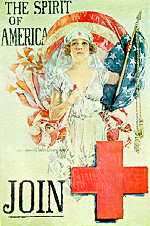
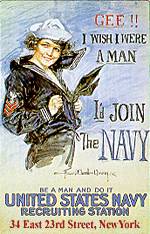 The
patriotism he displayed in the Spanish-American war was rekindled
during WWI. He drew upon that fervor and his tremendous talent
to create posters for the war effort. Among the most popular were
his Red Cross and Navy images, both featuring the famous Christy
Girl. A lesser-known, similar image appeared in the 1921 Naval
Academy yearbook, The Lucky Bag (see below).
The
patriotism he displayed in the Spanish-American war was rekindled
during WWI. He drew upon that fervor and his tremendous talent
to create posters for the war effort. Among the most popular were
his Red Cross and Navy images, both featuring the famous Christy
Girl. A lesser-known, similar image appeared in the 1921 Naval
Academy yearbook, The Lucky Bag (see below).
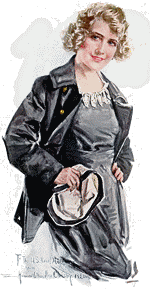
Between 1905 and the beginning of the war, Christy was one of the most popular artists in America. He was an occasional teacher at the best New York illustration schools: The Art Students League, Cooper Union, The New York School of Art and the Chase School that was founded by his early instructor. Most of this period was spent back in Ohio where he had built a studio.
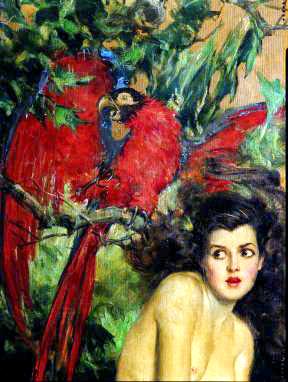
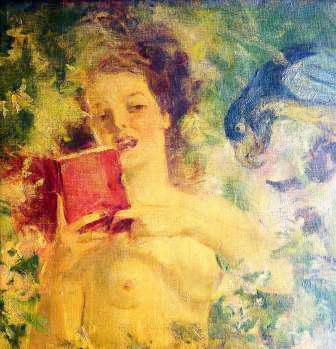 The
book and magazine market changed drastically after the war, and
Christy changed with it. He painted portraits instead. Such was
his popularity that he painted Presidents Franklin Roosevelt,
Calvin Coolidge and Herbert Hoover (as well as past Presidents
James Garfield, Martin Van Buren and James Polk), celebrities
like Will Rogers, Eddie Rickenbacker and Amelia Earhart, and powerful
figures like Benito Mussolini and Mr. and Mrs. William Randolph
Hearst. Throughout the decade of the 1920's, when he wasn't traveling,
he lived in New York City and had his studio at the Hotel des
Artistes. On the ground floor was the Cafe des Artistes, where
his wonderful murals of nudes are still on display. The images
at left and right are from their website.
The
book and magazine market changed drastically after the war, and
Christy changed with it. He painted portraits instead. Such was
his popularity that he painted Presidents Franklin Roosevelt,
Calvin Coolidge and Herbert Hoover (as well as past Presidents
James Garfield, Martin Van Buren and James Polk), celebrities
like Will Rogers, Eddie Rickenbacker and Amelia Earhart, and powerful
figures like Benito Mussolini and Mr. and Mrs. William Randolph
Hearst. Throughout the decade of the 1920's, when he wasn't traveling,
he lived in New York City and had his studio at the Hotel des
Artistes. On the ground floor was the Cafe des Artistes, where
his wonderful murals of nudes are still on display. The images
at left and right are from their website.
The Depression of the 1930's put a damper on his life as a
bon vivant. Still, he worked practically incessantly - whether
for commission or for himself. Many lively nudes showed that the
Christy Girl was, indeed, approachable. His murals adorn the Ohio
Statehouse and his most famous painting is the huge Scene
of the Signing of the Constitution of the United States
which hangs in the nation's Capitol.
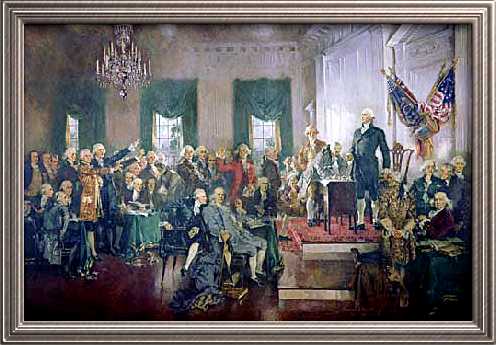
Christy died in 1952. He was elected to the Society of Illustrators Hall of Fame in 1980.
 To learn more about Howard Chandler Christy, see:
To learn more about Howard Chandler Christy, see:| The First World War in Posters | Joseph Darracott, 1974 Dover |
| 200 Years of American Illustration | Henry C. Pitz, 1977 Random House |
| The Illustrator in America 1880 to 1980 | Walt & Roger Reed, 1984 Madison Square |
| Famous American Illustrators | Arpi Ermoyan, 1997 Society of Illustrators |
| The Vadeboncoeur Collection of Knowledge | Jim Vadeboncoeur, Jr. 2000 |
| The Vadeboncoeur Collection of ImageS 5, B&W ImageS 2,3,5 | Jim Vadeboncoeur, Jr. 2003, 2004, 2006, 2010, JVJ Publishing |
|
Illustrations are copyright by their
respective owners. This page written, designed & © 2000 by Jim Vadeboncoeur, Jr. Updated 2011. |
